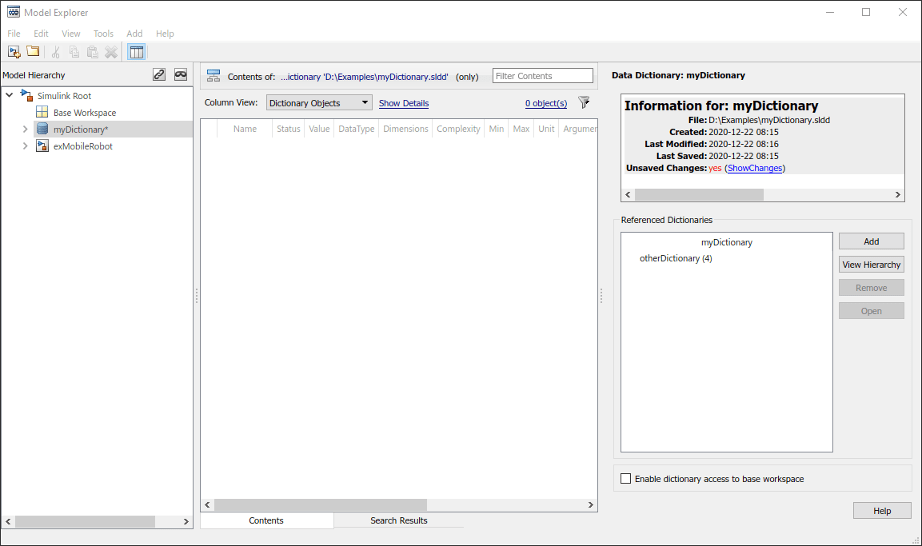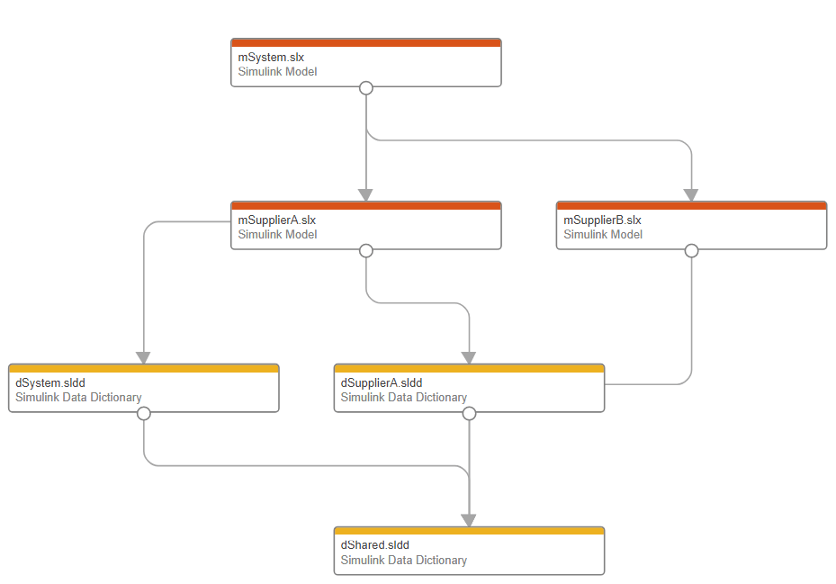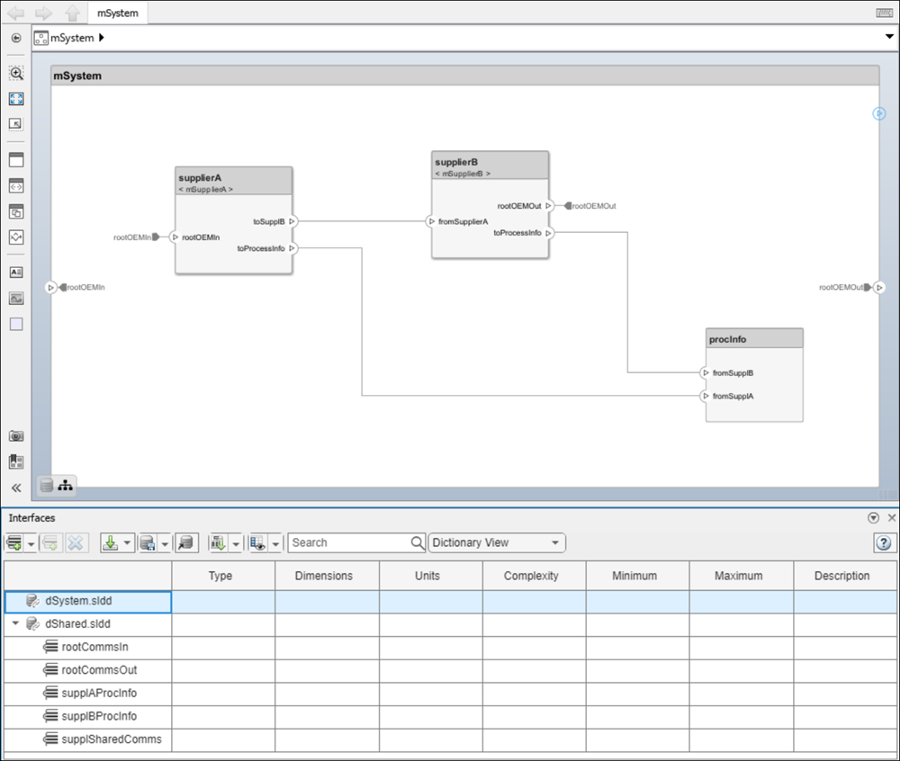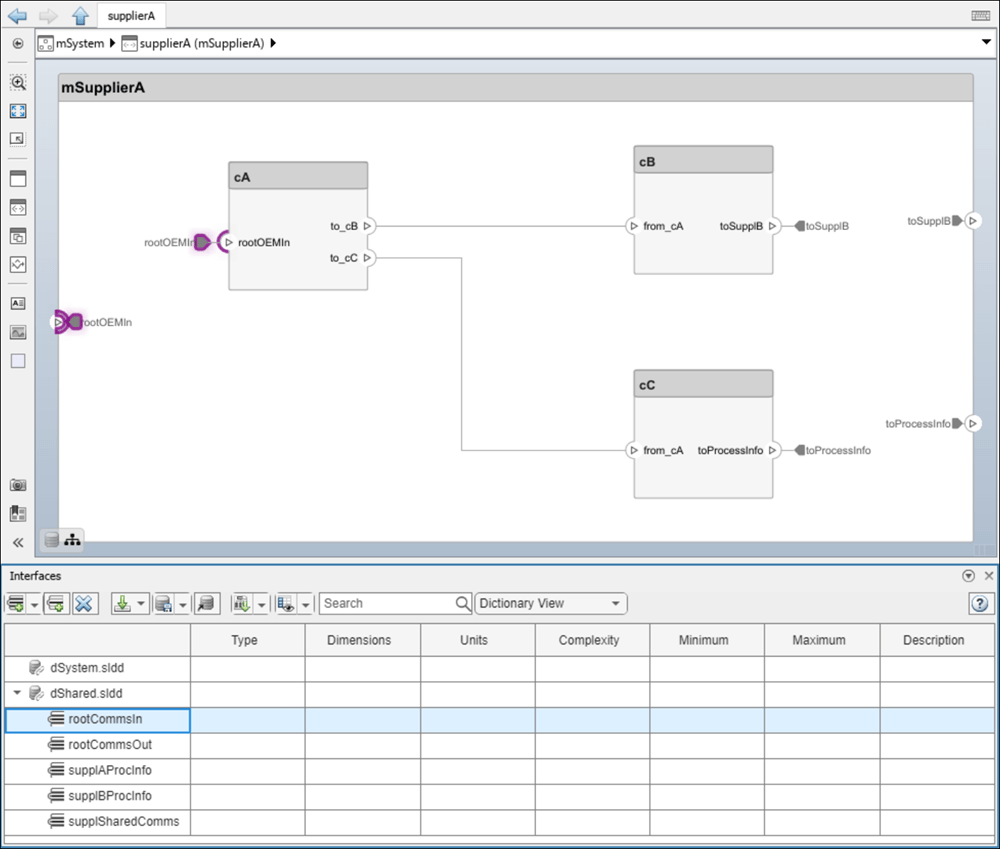引用数据字典
在以下情况下,System Composer™ 中引用的字典可能会非常有用:
多个模型需要共享一些(但不是全部)接口定义。
多个模型需要相互通信。
数据字典可以引用一个或多个其他数据字典。引用字典中的接口定义在父数据字典中可见,并可用于与父数据字典链接的模型。
关于接口术语,请参阅定义组件之间的端口接口。
要从模型字典中的接口创建数据字典,请参阅使用数据字典管理接口。
添加引用数据字典
要添加数据字典引用,请点击 ![]() 打开模型资源管理器,或导航至 建模 > 模型资源管理器。
打开模型资源管理器,或导航至 建模 > 模型资源管理器。
在模型资源管理器 App 的右侧,点击添加,然后选择要添加为引用数据字典的数据字典的文件名。要删除数据字典引用,请突出显示被引用的数据字典,然后点击删除。

接口编辑器显示模型可访问的所有接口,这些接口根据其数据字典文件分组。在此示例中,myDictionary.sldd 是链接到模型的数据字典,otherDictionary.sldd 是引用数据字典。

该模型可使用所列的任何接口。您可以在接口编辑器中修改引用数据字典的内容。
注意
引用数据字典可以引用其他数据字典。具有链接数据字典的模型可以访问引用数据字典中的所有接口定义,包括间接引用的数据字典。
在具有多个模型的工程中使用引用数据字典
一个工程可能包含多个模型,这些模型之间共享与数据流和模型之间其他通信相关的接口定义可能会非常有用。有关详细信息,请参阅整理工程中的 System Composer 文件。
同时,每个模型可能都有仅与其内部操作相关的接口定义。例如,系统的不同组件可以由不同的模型来表示,由不同的团队或不同的供应商负责每个模型,系统集成商负责整合各种组件的“顶层”模型。引用数据字典为模型提供了一种共享部分(而非全部)接口定义的方法。
在这样的多团队工程中,建立一个“共享工件”数据字典来存储不同团队将共享的接口定义,然后为工程中的每个模型建立一个数据字典来存储其自身的接口定义。然后,每个数据字典都可以将共享数据字典作为引用数据字典添加。或者,如果模型不需要自己的接口定义,则可以将共享数据字典链接到模型。
要生成模型与数据字典之间的依赖关系图,请使用依赖关系分析器。

上图描述了一个包含三个模型的工程。模型 mSystem.slx 代表系统集成模型,mSupplierA.slx 和 mSuppierB.slx 代表供应商模型。数据字典 dShared.sldd 包含所有模型共享的接口定义。系统集成模型链接到数据字典 dSystem.sldd,供应商 A 模型链接到数据字典 dSupplierA.sldd;每个数据字典都包含与相应模型内部工作流相关的接口定义。数据字典 dSystem.sldd 和 dSupplierA.sldd 都引用了共享数据字典 dShared.sldd。相比之下,mSuppierB.slx 模型直接链接到共享数据字典 dShared.sldd。这样,这三个模型都可以访问 dShared.sldd 中的接口定义。
下图显示了系统集成模型 mSystem 以及接口编辑器。引用数据字典 dShared 中包含的接口定义与用于在模型 mSupplierA 和 mSupplierB 与系统集成模型的其余部分之间进行通信的端口相关联。

下图显示了供应商模型 mSupplierA 以及接口编辑器。引用数据字典 dShared 中包含的接口定义与用于外部通信的端口相关联,而私有数据字典 dSupplierA 中的接口定义与 mSupplierA 模型内部使用的端口相关联。

另请参阅
addReference | removeReference | moveInterface